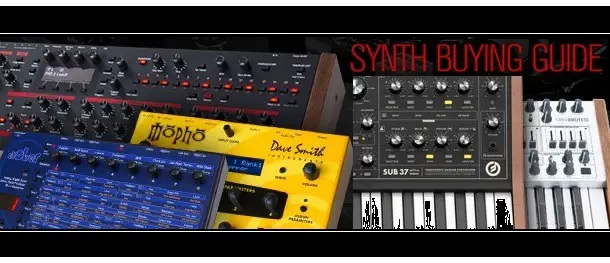
A keyboard synthesizer has the ability to generate and modify a wide range of sounds, making it a versatile tool for musicians and music producers. Keyboard synthesizers (playback and analog synths) are available in various sizes (including compact ones), have robust construction quality, and feature cutting edge sounds. These can be used as a midi controller as well to play soft synths.
Introduction
There comes a time when a keyboard player wants to move from using preset sounds to making their own sounds or needs access to cutting edge sounds. If you can relate to that, perhaps it is time to move away from your arranger or digital piano, and consider buying a synthesizer.
Unlike a typical electronic keyboard, a keyboard synth (workstation) produces rich sounds and lets you manipulate the sounds to your liking.
A synth might look similar to an arranger keyboard; you will also find a synth-action on both these instruments, but that is where most of the comparison ends.
A synthesizer gives you lot of tools to tweak and create new sounds.
A synthesizer keyboard with its sound tweaking capabilities, various pattern generating capabilities, audio recording and editing features makes it quite a different beast from an arranger keyboard.
A Synthesizer can not only emulate a wide variety of sounds, but can also be used to create your own unique sounds (besides natural sounds). You can use a synth to create variations of electric pianos, or effects such as UFO landing sound, via the several options and controls available on a synthesizer.
A basic understanding of synthesis is all that you need to dig into the various features of these synth keyboards.
Type of Synthesis
Basically, you get two types of keyboard synthesizers depending on the type of sounds generated – Analog Synths and sample Playback Synths.
- Sample Playback Synths include more of the bread and butter type of sounds. If you are more into pop, jazz, orchestral or mainstream type of music then you will need authentic piano, string, brass sounds. And that is what a Sample Playback Synth provides.
- Analog Synthesizers (also known as Virtual Analog synths or VA synths) are for those who only prefer doing dance, trance, techno type of music. It gives you a palette of sounds that suits these styles of music, something which sample playback synths cannot provide.
Most synthesizers do not come with built-in speakers, so you will need good external speakers/amps to hear your keyboard synthesizer’s output.
Keyboard synthesizers are available in various sizes (88 keys, 76-keys, 61 keys, 49-keys, 37-keys), but the more common ones are the 61-Key and the smaller-sized Synthesizers. In terms of features, except for the number of keys, all of them have more or less the same functions.
Musicians however have their own preferences when it comes to the number of keys.
Some prefer synthesizers with more keys (such as 88-keys) as it provides them with a wide dynamic range (lower octaves, higher octaves); some prefer compact synthesizers as the small size fits into any stage or studio rig, suitable for the space-conscious musicians (these are also perfect instruments to get started with analog modeling).
Experienced users usually own multiple keyboards, which may include a combination of beginner synths, analog synths and/or workstations.
So here are the top reasons why you should consider buying a Synthesizer:
- Studio quality sounds. Most Hardware synthesizers producer better sounds than software
- Amazing sounds, patterns & sequencer
- Create unique sounding music
- You can control almost every parameter related to sound.
- These are great for experimenting with new sounds and introducing new ideas
- Multi-track Recorder for Audio & MIDI, with onboard mixer and dedicated transport controls
- Tweak the Sounds – Knobs and Buttons to tweak the sounds as you wish.
- Built-in Arpeggiator and Multi-Effects
- Interface to PC – Easily connected to a PC or Mac through the USB port
Beginner Synthesizers: Affordable, Entry Level Hardware Synths
Most musicians looking for a beginner synth are not really piano/keyboard players (in the classic sense) and neither are they looking for the home arranger keyboards that come with several accompaniments and with very little editing features.
What they want is a keyboard that lets them tweak the sounds, something that lets them create unique (and at times weird sounds) so that people around can say “Wow”. A synthesizer is an instrument that lets you do such things.
Now, some synthesizers may let you do that easily whereas on some you have to navigate several menus to apply the various functions to allow you to do this in different ways, some easier than others.
Different musicians have different needs and accordingly they choose their synths:
- Some use it specifically for the deep synth bass sounds, but there are many who use it for much more then that.
- Some prefer a synth with more of bread-and-butter sounds (piano, organ, strings, etc.) so that it can suit a variety of genres of music.
- Some prefer synth with smaller keys for gigging (portable), if they already own another 88-key keyboard/piano.
- Almost all prefer an easy to use interface with dedicated buttons for the various functions, rather than selecting them from the various menus/screen.
Since synthesizers are used mostly for live use, they have an easy to use interface with LOTS of knobs and sliders to make it easy for use to control the various parameters.
A keyboard that is dependent a lot on its menu for selection is more suitable for home or studio use. So all those knobs make finding and adjusting sounds a lot easier!
Analog sounds are used a lot in electronic music and since we are talking about entry level synth keyboards, you are most likely to get a V.A or Virtual analog synth (uses digital technology) as opposed to a real analog synth (these are more expensive but produce some deep synth sounds).
You also have the option of using software synths (sound samples) If you really don’t want to spend on these hardware synths. You will need a computer, MIDI controller keyboard, sound samples, and music production software.
But then the advantage of a hardware synth is that it’s easy to set it up, just plug in headphones or speakers and you are ready to hear the various sounds.
There are many who prefer the “presets” as they are easier to use, but them you don’t get to learn more about synthesis. You should spend time designing your own patches so that you can appreciate more the capabilities of such instruments.
‘Mid-Range’ Synthesizer Keyboards
Here are some ‘Mid-Range’ synthesizer keyboards for he cost-conscious musicians that can be used for on-stage performances as well as in the studio. These may have smaller screens, may use some plastic parts, but they offer premium sounds and professional effects and are great performance keyboards.
Yamaha MX61 61-Key Synthesizer
 The Yamaha MX61 Music Synthesizer offers over 1000 voices from the Motif soundset, vintage effects emulations, and easy on-the-fly splits and layers, and more. Designed with the gigging musician in mind. You can use the Yamaha MX keyboards as a basic stereo USB audio interface, it has respectable control surface functionality for most popular DAW software.
The Yamaha MX61 Music Synthesizer offers over 1000 voices from the Motif soundset, vintage effects emulations, and easy on-the-fly splits and layers, and more. Designed with the gigging musician in mind. You can use the Yamaha MX keyboards as a basic stereo USB audio interface, it has respectable control surface functionality for most popular DAW software.
Roland Juno DS Synthesizers
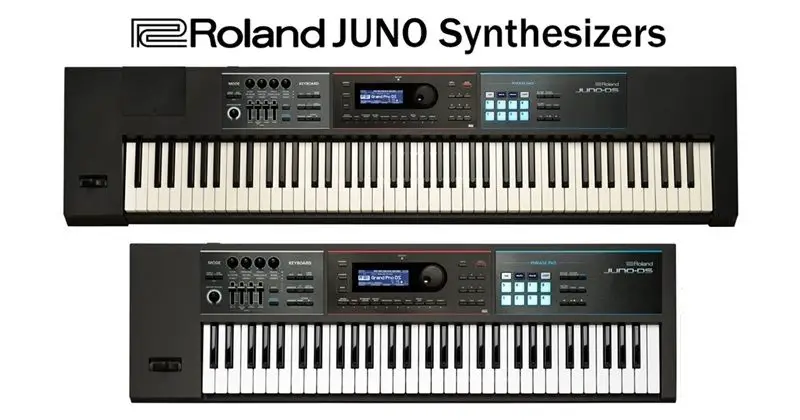 The Roland JUNO-DS (available in 61 keys and 88 keys) is a complete performance synth laden with several features, including the ability to sing along and apply voice effects through the mic. It comes with a built-in song player for larger-than-life performances.
The Roland JUNO-DS (available in 61 keys and 88 keys) is a complete performance synth laden with several features, including the ability to sing along and apply voice effects through the mic. It comes with a built-in song player for larger-than-life performances.
These synthesizers provide top-class sound & performance features under your Fingertips, delivers the finest sounds in the market. These feature thousands of sounds (1500+ patches) along with world-class multi-effects, realtime performance controllers; you get all the tools to create and compose rocking grooves.
- Roland JUNO-DS61: Weighs under-12-pound, 1500+ patches, add samples on USB stick
- Roland JUNO-DS88: 88 weighted keys
Compact Keyboard Synthesizers
These synths are compact in size and lightweight (but the action is still good). There are many musicians who prefer these to carrying heavy 88-keys hammer-action synths/controllers around to gigs.
Roland GAIA 2 Synthesizer
Roland synthesizers are known for their well thought of layout and this is no different. The SH-01 is based on Roland’s proprietary virtual analog synthesis engine. An intuitive layout with dedicated controls and knobs; this synth is suitable for most beginners. Read more…
Novation MiniNova Analog Modeling Sythesizer
A tiny synth with powerful analog-modeling engine that lets you create huge sounds. You can even run your voice through the built-in microphone/vocoder.
Korg microKorg Analog Modeling Synthesizer with Vocoder
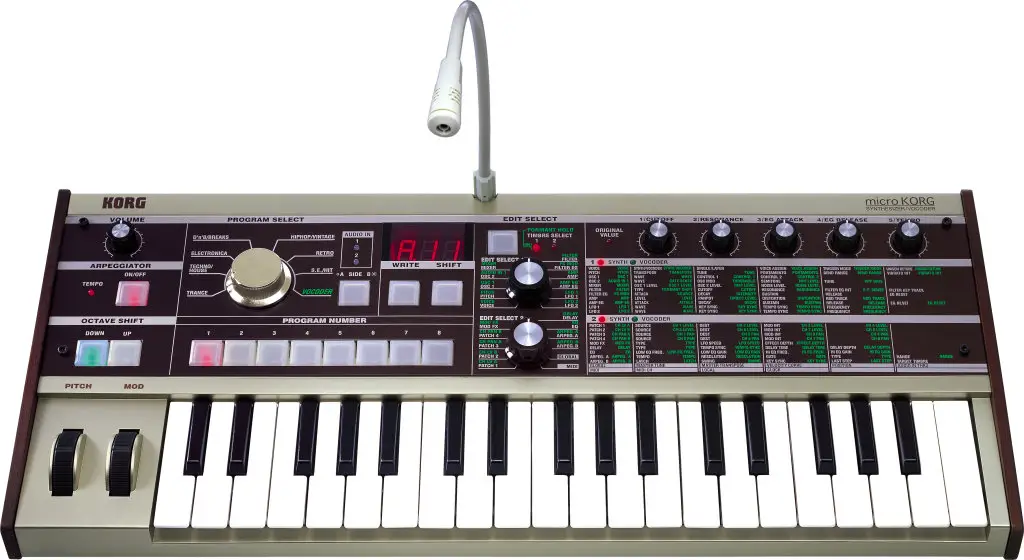 This is a powerful synthesizer from Korg that is perfect for the musician looking for a serious yet affordable synthesizer. You get a powerful sound synthesis engine, 8-band vocoder with several features, a full range of effects, and a flexible arpeggiator. Even with only 37 keys, this is indeed a very usable keyboard.
This is a powerful synthesizer from Korg that is perfect for the musician looking for a serious yet affordable synthesizer. You get a powerful sound synthesis engine, 8-band vocoder with several features, a full range of effects, and a flexible arpeggiator. Even with only 37 keys, this is indeed a very usable keyboard.
Pocket Synthesizers
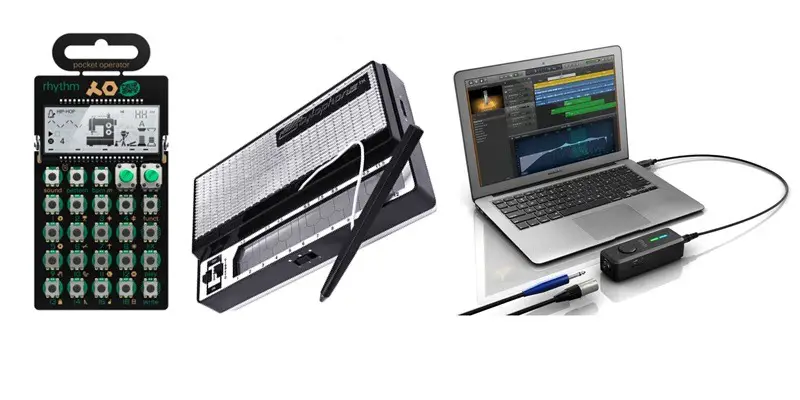
Pocket synthesizers may come across as gimmicks but these provide an affordable route into electronic music production. The portability aspect of these high-performance hardware also make them quite popular among musicians. These have built-in speakers, headphone jacks, and you can also connect external music players to this synth.
Korg Volca Beats Analog Rhythm Machine
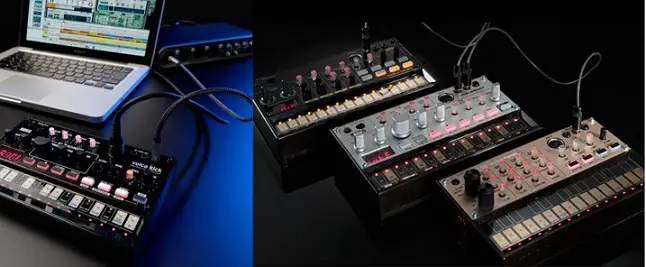 Analog rhythm machine that delivers the ultimate sounds and grooves with ease and depth. Create authentic analog drum sounds, complete with a PCM sound engine. MIDI compatible. Electribe-style step sequencer, stutter function, active step function, and step jump function.
Analog rhythm machine that delivers the ultimate sounds and grooves with ease and depth. Create authentic analog drum sounds, complete with a PCM sound engine. MIDI compatible. Electribe-style step sequencer, stutter function, active step function, and step jump function.
Korg Monotron Duo Analog Pocket Synthesizer
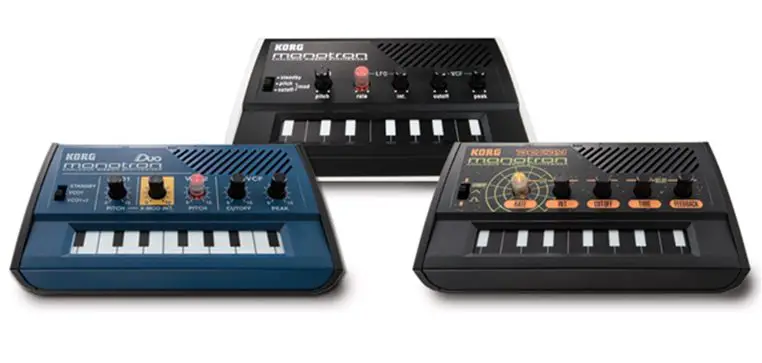 Korg’s monotron DUO analog synthesizer ha a no-frills design but gives you two voltage-controlled oscillators (hence the name DUO) and the same voltage-controller filter circuit from the revered Korg MS10 and MS20 synths. Get thick sound only possible with an analog synth.
Korg’s monotron DUO analog synthesizer ha a no-frills design but gives you two voltage-controlled oscillators (hence the name DUO) and the same voltage-controller filter circuit from the revered Korg MS10 and MS20 synths. Get thick sound only possible with an analog synth.
Teenage Engineering Synthesizers
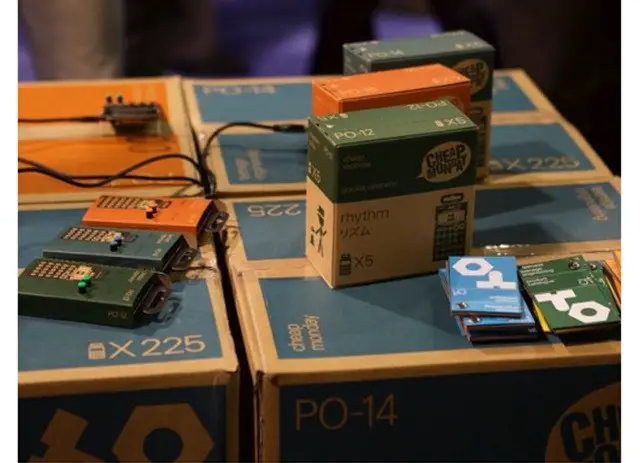
Swedish company Teenage Engineering has managed to carve out a niche for themselves in the world of electronic music. Teenage Engineering synths put a whole lot of music-making power in your hands. If you’re a budding DJ, club kid, or general jam lover, you can create big sounds using these mini sized gadgets. These have palm-sized circuit boards, display animated graphics on an LCD display, have real synthesizer engines, built-in effects, built-in speaker, etc.
Synths Without Keys (Sound Module)
Korg Kaossilator Pro+
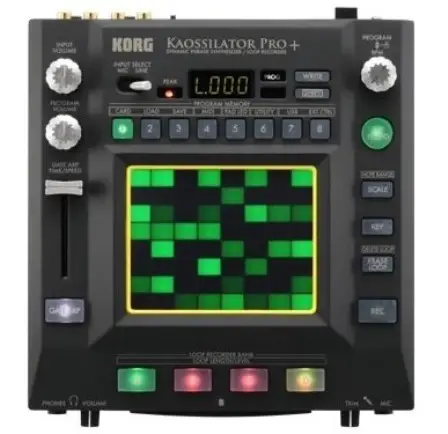 The Korg Kaossilator Pro Plus synthesizer (KoPro+) lets you play musical phrases with hundreds of cutting-edge Korg synth sounds, without requiring any keyboard skills. Its a great instrument to have in your rig, especially if you have limited or no keyboard skills.
The Korg Kaossilator Pro Plus synthesizer (KoPro+) lets you play musical phrases with hundreds of cutting-edge Korg synth sounds, without requiring any keyboard skills. Its a great instrument to have in your rig, especially if you have limited or no keyboard skills.
You can trigger and manipulate loops and patterns using only the touchpad. Samples and loops are controlled simply by tapping or swiping your finger across the X/Y touchpad. Horizontal motions control the pitch while vertical motions affect other parameters such as filter cutoff, feedback, or modulation depth.
Korg Volca Synth Series: Keys, Kick, Bass, Beats
 The Korg Volca series of analog synthesizers (used for EDM production) currently include the Volca Keys (Analogue Loop Synth), the Volca Bass (Analogue Bass Machine), the Volca Beats (Analogue Rhythm Machine), and Volca Kick (drum machine with 16-step sequencer).
The Korg Volca series of analog synthesizers (used for EDM production) currently include the Volca Keys (Analogue Loop Synth), the Volca Bass (Analogue Bass Machine), the Volca Beats (Analogue Rhythm Machine), and Volca Kick (drum machine with 16-step sequencer).
Here’s what makes these popular analog synths.
- Each of these come with built-in sequencers.
- You can connect multiple ‘volcas’ via the vintage-style sync in/out, and with your favorite DAW software or to a MIDI keyboard via MIDI In.
- These have one-touch variations and time divisions to make on-the-fly changes to a pattern.
- Its portable and capable of running on batteries (also works on AC adaptor)
- Built-in speakers allow you to use the synthesizer anywhere and anytime (it also has headphone mini jack).
- Use it for performance or in the studio
Buying Links.
- Korg Volca Keys Analog Loop Synthesizer
- Korg Volca Beats Analog Rhythm Machine
- Korg volca kick Bass Drum Synthesizer
- Korg Volca Bass Analog Bass Machine Synthesizer
- Korg AC Adapter for Volca Series (9v DC, 1700ma Center Positive)
- Decksaver Korg Volca Series Cover
Tabletop (desktop) synthesizers are smaller in size and come without a keyboard. You have to plug in a MIDI keyboard in order to use the sounds; these come with several knobs that can be tweaked to make blips, bleeps and sweeps. Checkout these tabletop synths here.
Additional Reading
- Best Synth Keyboards under $1000: Professional synth keyboards, priced well within the reach of the working musician.
- Best Music Workstation Keyboards: The best synths & workstation available for professionals.
- 88-Key Piano Synthesizer: Piano synths offer the perfect Balance of Synth and Piano Keyboard
- Professional Synthesizers from Yamaha
- Full-Featured Keyboard Synthesizers from Roland
Top Synthesizers for Various Price Ranges
Arturia MiniBrute-2 Analog Keyboard Synthesizer
ARTURIA MiniBrute 2 is successor to the popular MiniBrute. Arturia MiniBrute 2 offers more options, more modularity, full-size Keys. Besides the MiniBrute 2, Arturia also launched the MiniBrute 2S that swaps a traditional keyboard for performance pads and a sequencer that can be recorded in real time.
The MiniBrute 2 features two oscillators with waveform mixing, multi-mode Steiner Parker filter; LFOs, ADSR and AD envelopes, and a hybrid step-sequencer and arpeggiator inherited from Arturia’s Keystep devices; 25 full-size velocity sensitive keys with aftertouch; Pitch and modulation wheels not found on the original; Arturia’s own Brute Factor feedback circuit.
The new analog synth now comes with a second oscillator, a semi-modular architecture and more.
The purchase also includes a hardcover book where you can find various sounds to re-program; these example sounds helps you understand the engine as well as give you ideas to craft interesting sounds.
Buy Arturia MiniFreak Hybrid (37-Key) on zZounds.
Korg MicroKorg 37-Key Analog Synth
The Korg microKorg is one of the most popular and successful products from Korg, a brand that is well-known for producing top quality synthesizers. The Korg microKORG has a great fan following thanks to its easy-to-use interface, sturdy build quality, vocoder, amazing sounds and a reasonable pricing.
The popular Korg MicroKorg comes with a huge library of analog-style synth sounds, an on-board vocoder, 8-step arpeggiator, and more, in a tiny, battery powered, 5-pound MicroKORG, and includes a cool gooseneck microphone.

And this keyboard is not just for keyboard players, the microKORG can be used by bassists who need some killer synth bass-sounds, by vocalists who want to add some sonic extras, or for that matter, by any musician.
Korg microKORG S Synthesiser
Now Korg has introduced the new microKorg-S with more sounds, more space for custom presets, comes with an integrated 2+1 speaker system, and comes with a new sophisticated look.
The Korg microKORG S offers all the features of the original synth (including the vocoder).

Waldorf Blofeld 49-Key Synthesizer
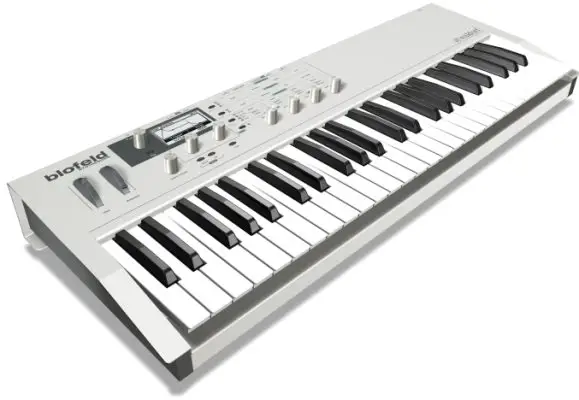
The 49-key Waldorf’s Blofeld synth module is one killer virtual-analog synth that’s ready for any stage or studio rig! And it looks great too, with elegant stainless-steel knobs and a metal case, this compact powerhouse is a marvel of German engineering. This killer virtual-analog synth fits in nicely in the studio as well as onstage.
Whopping 60 megabytes of sample memory and over 1,000 sounds. Virtual analog, wavetable, and sample-based oscillators. Pitch bend wheel, modulation wheel, and sustain pedal connector. Polyphony of Max. 25 voices. Backlit graphic display. 3 Oscillators, 2 filters per voice , 2 independent multi-mode filters per voice, 3 fast LFOs per voice, 4 fast Envelopes per voice. Freely programmable arpeggiator pattern with up to 16 steps per sound.
Moog Little Phatty II Stage
Although digital might be the norm today, the world’s most celebrated analog synth maker still has a great reputation among serious musicians.
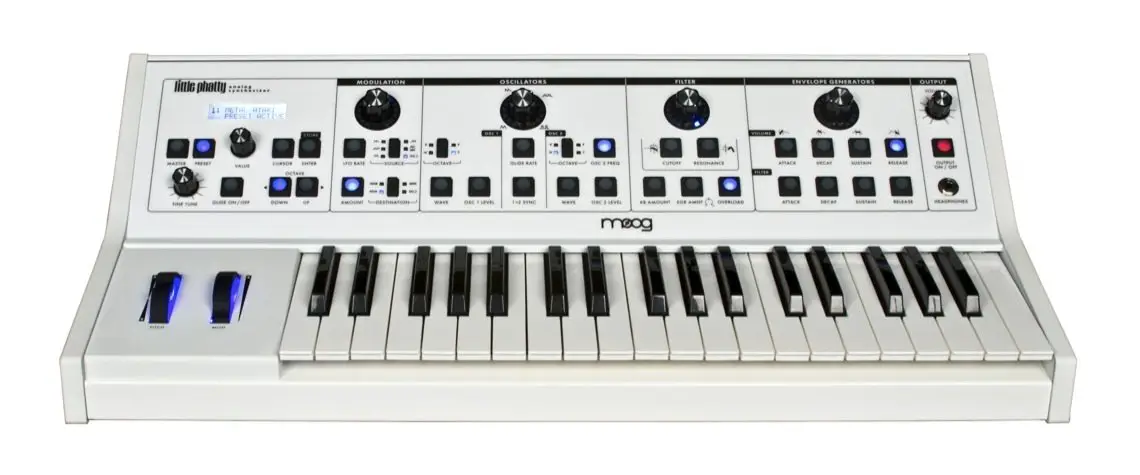
For around thousand dollars, the Moog Little Phatty Stage II is among the world’s most celebrated analog synths, with powerful monophonic sound, sweet arpeggiator, and a punchy voice that won’t be easily missed.
It comes with MIDI connectivity, dual VCOs and a 100% analog signal path. With Moog Music’s Little Phatty Stage II, you’ll get a powerful and punchy voice that won’t be easily missed.
Behringer MS-101
Behringer announced the new MS-101 analog Synthesizer, based on the popular Roland SH-101 Synthesizer. The synth comes with several new features, with new FM possibilities, new step sequencer as well as many connections for external instruments.
Monophonic synthesizer with authentic 3340 analog oscillator that produces insanely fat sound
32 semi-weighted full-size keys
Arpeggiator, pitch bend wheel and a pitch modulation trigger
Guitar strap included for live jamming on stage
Moog Synthesizer Keyboards
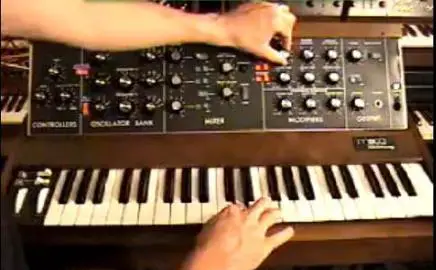 Moog’s classic analog synths have been used on countless recordings over the years. Their endearing analog sound and unique sonic capabilities make them popular instruments even today.
Moog’s classic analog synths have been used on countless recordings over the years. Their endearing analog sound and unique sonic capabilities make them popular instruments even today.
Named after its founder Robert Moog, Moog Music builds analog synthesizers, theremins, effects pedals, and few other music gear.
The company started off manufacturing Theremins but today it produces a wide range of instruments and effects that are known for its outstanding craftsmanship and quality.
Please note that the actual pronunciation of the brand name rhymes with the word “rogue” (and not a drawn-out “oooo” sound).
Popular Moog Synthesizers include the Voyager, Prodigy, Little Phatty, and other analog synths.
Moog Accessories
Moog Mother-32 and DFAM Gig Bag
Designed specifically to fit the Mother-32 and DFAM analog synthesizer units, this official gig bag from Moog keeps your synths protected during travel.
Buy on zZounds
Moog Mother-32 Cable Set, Moog 6″ Modular Patch Cables
Buy on zZounds
Synthesizers: Detailed Guide
Synthesizer vs Electronic Keyboard (for Beginners)
A Synthesizer Keyboard is basically a sound-generating machine and unlike an Arranger keyboard, it does not contain built-in musical sequences, intros, accompaniments, and fill ins. Instead, it contains loops and arpeggios which can be modulated and stored to be played back later.
A musical keyboard will also NOT let you tweak the built-in sounds…may be it will let you to a limited extent. Keyboard synthesizers on the other hand will let you do much more. You can create rich, amazing sounds to some extremely wacky ones. The editing features on a synthesizer keyboard make it different from arrangers.
Even synthesizers are available in various sizes (25, 37, 61, 72, 76, 88 keys) and come with varied action – synth action, semi-weighted and weighted.
Synths can produce melody as well as percussion sounds ranging from reed instruments to drums. But its true power is its possibility to create completely new and unheard of sounds. Synths provide you with different ways to create extremely sophisticated sounds. You can choose to either program these in, or you can operate in real time to give your sounds a high degree of expressive life.
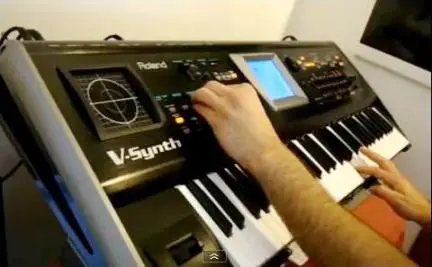
Synthesizers are technically superior instruments, are more expensive and it gives you the capability to manipulate almost any of the parameters associated with the built-in sounds.
Unlike musical keyboards, they do not have built-in accompaniments and speakers; you will need external speakers to generate sounds.
Recommended Best synthesizers:
- Best Beginner Synthesizer / Entry Level Synths
These synths are inexpensive, but do not cut down on the core features. These are great to test the waters, can be your first synth. - Best Synthesizer Keyboards under $700
For the cost-conscious musicians, these synths offer premium sounds and professional effects. - Best Synth Keyboards under $1000
Professional synth keyboards, priced well within the reach of the working musician. - Best Music Workstation Keyboards
The best synths & workstation available for professionals.
How is the Sound Produced in a Synthesizer
The Oscillator is a common term that you will here, and it is the component that generates the sound. It generates a frequency and sets the pitch of the sound as well as the waveform of the sound.
Things to remember:
- Higher tones / pitches will have higher frequencies
- Lower tones / bass tones will have lower frequencies
The better synthesizers come with more oscillators, so that they can generate several kinds of frequencies. The frequency generated is then fed to the filter to give you better control over he sound.
What does a filter do?
It removes certain frequencies and harmonics and gives you better control over the sound that you are trying to synthesize. The better synthesizers provide you with several kinds of filters so that you can apply the proper effects.
There’s an Amplifier too
Synthesizers use electricity to generate the frequencies, but then they are not powerful enough to be heard properly on their own. This is where an amplifier is required; it amplifies the signal so that it becomes powerful enough to be heard through the speakers.
Envelope Generator
So now you are aware of oscillators, filters and the amplifier.
You need another component that can control the output from these, and that is where the envelope generator comes into picture. It also decides when should the sound start or end.
- When applied to the oscillator – it can change the pitch
- When applied to the filters – it can change the brightness, timbre
- When applied to the amplifier – it can change the volume
- It can also change the overall timbre of the sound.
So these are the common components of any synthesizer, and when you are tweaking the sounds, you are actually controlling these components.
This is how a Synthesizer produces sound.
How Does a Synth Keyboard Let You Create Your Own Sounds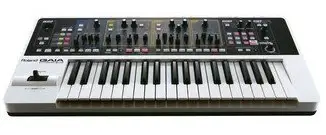 A Synth Keyboard gives you a lot of control by letting you modify sound related parameters. Here’s how a synth keyboard let you create your own sounds.
A Synth Keyboard gives you a lot of control by letting you modify sound related parameters. Here’s how a synth keyboard let you create your own sounds.
Sound Generating Elements
A synthesizer includes sound generating elements which creates a basic set of audio waveforms.
Now, to create a different sound you should be able to modulate or change these waveforms. This is the reason synthesizers come with so many knobs, sliders and buttons.
These controls let you modulate the basic waveforms so that you can create sounds with totally different patterns. Using the knobs and sliders, you can change the waveforms pitch, frequency, amplitude and other parameters to create entirely new sounds.
The following are some of its features:
- It produces waveforms and lets you modulate (change) them to create new audio waveforms
- It doesn’t contain accompaniments nor do they have built-in speakers
- It contains loops, arpeggios and effects
- Extremely versatile
- Used to create sounds that can be used as sound effects in background scores
- Used mostly in studios
- Used by lot of keyboardists to play in a band because of their stunning sounds and effects.
How To Add Effects?
You will find this section in all the synths and this is what lets you alter the waveform to produce that different sound.
A particular sound or timbre sounds that way because of the waveform generated and you can change it by altering these four things:
- Attack – This is the time taken for a sound to reach its maximum level after a key is pressed.
- Decay – This is the rate at which the volume decreases from that maximum level.
- Sustain – This is the level of the sound while the key remains pressed.
- Release – this is the duration of the sound after the key is released.
Here are a couple of videos explaining the Fundamentals of Synthesizer Programming
Using Arpeggiator / Arpeggio Patterns on Synthesizers
This is an awesome feature available on synths!
An arpeggiator lets you play a variety of phrases and arpeggio patterns using just one finger!
Some of the synths may provide you with two polyphonic arpeggiators, making it possible to create even more sophisticated patterns!
You may use the two arpeggiators to play two different instruments – for instance drums and bass, while you play your chords and melody. This feature gives you amazing power for your live performances.
Most of these synths provide you with numerous patterns to choose from. They even let you create your own original patterns, which you can then store in the internal memory for later use.
You can read more on the Arpeggio Function of a Keyboard Synth here.
Additional Features
Do You Need an Onboard Sequencer on a Synthesizer?
Almost all the beginner keyboards and digital pianos provide you with a built-in sequencer but that is quite basic. It does the basic job of recording the tracks but that’s it.
Lot of musicians over time switch to a computer based setup where they use a software sequencer program to do all the sequencing, editing and mixing stuff.
But that doesn’t mean that you don’t get keyboards which have better sequencing features. It’s just that you need to decide if you really want one.
But why would you need one with good sequencing abilities? There could be many reasons – if you are seriously into music programming and performing.
Why do you have to switch on the computer everytime you have some cool idea that you wish to expand upon. You can straightaway start creating using the synthesizer’s sequencer.
You do a lot of gigs? Then a synth with sequencer and an arpeggiator is a good combination to have. Ideally you need one on which the arpeggiators can sync to the MIDI clock coming from the sequencer. With the press of one button you can create sequence by switching on the arpeggiator and pressing a chord.
But then you can also accomplish all these using a software sequencer such as Sonar, Cubase or Logic. So if you don’t have a keyboard based one, you don’t have to fret!
Free Bundled Sequencing Software
Besides the features listed above, most of the 61 Key Synthesizers will offer you free sequencing software along with the instrument, when you make a purchase.
So if you have been planning to buy a sequencing software program, just hold on. You may get it free along with your 61 Key Synthesizer.
Additional Reading
- Moog Synth/Synthesizers
- 88 Key Synthesizers – Perfect Balance of Synthesizer and Piano
- Professional Synthesizers from Yamaha
- Full-Featured Synthesizers from Roland
- How to create a unique tone using the Synthesizer
- Learn How to Use the Arpeggio Function on Keyboard Synths
- How to Use Multi Pads on Keyboards?
Back to Home page from Keyboard Synthesizer
KeytarHQ editorial team includes musicians who write and review products for pianists, keyboardists, guitarists & other musicians. KeytarHQ is the best online resource for information on keyboards, pianos, synths, keytars, guitars and music gear for musicians of all abilities, ages and interests.



Leave a Reply